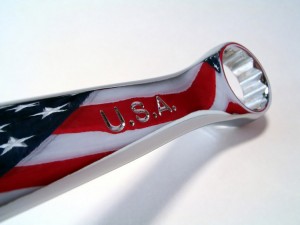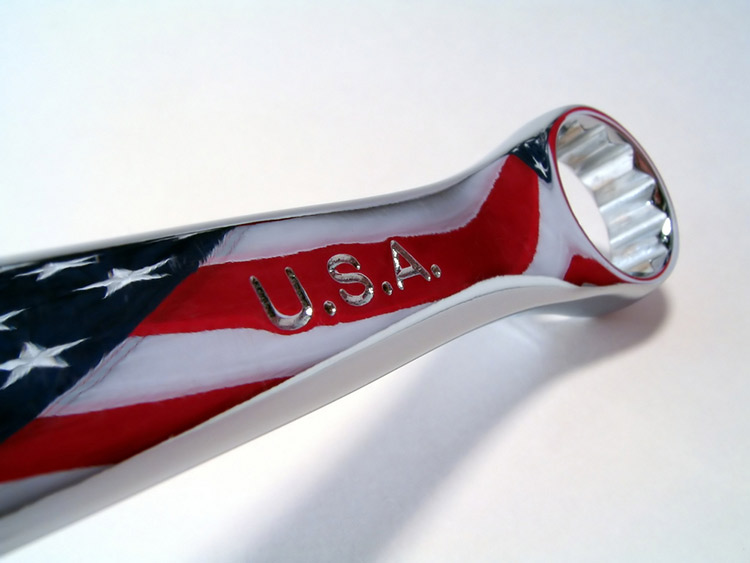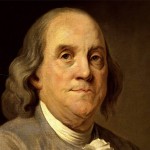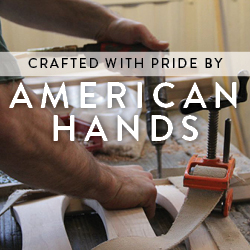History books have been written that fully explore the history of America in depth. This article only seeks to highlight the major points that allow you the reader to get a general grasp of the history of American manufacturing so that you can appreciate the importance of a robust manufacturing base and its vital interest in the continued success of the United States of America. The two key pillars that defined the American spirit that was regarded as the difference maker in what made America and Americans special are entrepreneurialism and mercantilism.
The definition of an Entrepreneur
“A person who organizes and manages any enterprise, especially a business, usually with considerable initiative and risk.” –dictonary.com definition
The definition of Mercantilism
“A theory prevalent in Europe and America during the 17th & 18th centuries asserting that the wealth of a nation depends on the possession of precious metals and therefore that the government of a nation must maximize a foreign trade surplus and foster national commercial interests.” – dictionary.com definition
“Labor was the first price, the original money that was paid for all things“. – Adam Smith
To appreciate America, its culture, and its people, to comprehend how we as a nation arrived at where we are now from where we first started, one has to understand why people from other countries came to this land in the first place. To comprehend the reasons, the impetus, of why the first people left the land of their birth in Europe and made the long, dangerous journey across the Atlantic Ocean, to brave the hardships and dangers in the new world, you have to look at the religious persecution that was taking place in Europe. The average American living today in the freedom that we all enjoy has difficulty understanding how people who supposedly shared a common faith, that being Christianity, could be persecuted with such fervor. This persecution would drive the oppressed to flee their country and seek a new beginning in the strange and hostile land that was the American continent in the 1600’s. Jamestown was the first permanent settlement in the new world but was not successful until many years afterward, only one out of every six colonists who left Britain survived. In 1620 the Pilgrims, who landed at Plymouth, Massachusetts founded a colony that became a beacon for others needing a new beginning.
“All great and honorable actions are accompanied with great difficulties, and both must be enterprised and overcome with answerable courage.” – William Bradford
One of the principals that drove these first colonists was the belief that God loved hard work and industrious natures. This belief system fueled these Pilgrims and later the Puritans of Boston to focus on a diligent work ethic that kept these sojourners in a new land alive and ultimately helped to make them wealthy. This industrious nature became the thriving heartbeat of the people who populated the land that would eventually become America. This new world afforded opportunities that could not be found anywhere else, to those who were willing to work hard and smart. The ability to change your future without regard to where you were born or what family you were born into was a wholly unique opportunity not found anywhere else in the world at this time. The world over, the masses worked for the betterment and enrichment of the so-called “noble” entitled classes. Whatever station of life you were born into; you were doomed to stay there with almost no exception. The settlers of this new country seized the opportunity they were given with zeal, and when others saw what was possible they too wanted to become part of the new world being made.
Since the beginning of recorded history, there has been the wealthy ruling class and the poor servant class. It was not until the ruling elite loosened their authoritarian grip on the economy that a new class was born, the merchant class, the middle class. The theory of mercantilism in the eyes of the ruling nobility was not necessary, their wealth was inherited, passed down from one generation to the next and work was considered beneath them. It was the merchants, the businessmen, who understood how new wealth is created. These merchants saw what an incredibly valuable theory this was not only for their nation but themselves as well. When the ruling elite saw the tax money that could be obtained from the buying and selling of goods it became a popular theory that ultimately became best exemplified in the fledgling colonies of America.
“It is not from the benevolence of the butcher, the brewer, or the baker that we expect our dinner, but from their regard to their own self-interest.” – Adam Smith
It was in America that ordinary men, without titles or noble lineage, with an entrepreneurial spirit and the belief that through their hard work and intelligent decision making could change the world as it was and they, could rise above the station in life that they were born into. This was a revolutionary idea, and it was out of this idea that the belief was born that “We hold these truths to be self-evident, that all men are created equal, that they are endowed, by their Creator, with certain unalienable Rights, that among these are Life, Liberty, and the pursuit of Happiness”.
“Individual Ambition Serves the Common Good.” – Adam Smith
In the 1700’s in America, manufacturing was limited to the production of products within private homes and small workshops and was simply for the needs of the local community. It was not until after the Revolutionary war that a man by the name of Samuel Slater opened the first factory in America in 1790. This factory was based on secrets of textile manufacturing that Samuel Slater brought with him from Britain. This first factory was powered by a water-wheel and became the first building block of many upon which the American textile industry was born. Textile manufacturing became the dominant industry in America with companies being created, numbering in the hundreds.
The American Industrial Revolution followed Britain’s running from 1820-1870. The industrial revolution itself refers to the switch from hand and home production to machine and factory. The factory owners in America sought to avoid the horrid working conditions found throughout England though child labor and abusive working conditions were prevalent. The industrialization of America was made possible due to the convergence of three critically important developments. The expansion of transportation options and the building of infrastructure which supported it was one development; the second was improvements to the refining of materials and the acceleration of production while the third was the harnessing and commercialization of electricity.
The first 30 years of the 1800’s saw America’s manufacturing grow at a torrid pace. The reasons for this were the invention of many world changing products. Eli Whitney invented the cotton gin in 1794, making the commercialization of cotton profitable. Eli Whitney’s second invention was arguably more important than his first. In modern America, the mass production of a product being put together with parts that were produced by another factory is so ubiquitous, no one thinks anything of it. In 1798, all muskets were made one at a time with parts that were made specifically for that musket, this meant that a craftsman had to fit each piece together individually to make it work, a tedious and time-consuming process which in turn meant the costs had to be much higher because of the labor involved and the unfortunate fact that pieces from two or more different muskets couldn’t be put together, and everything would work properly. Eli Whitney invented the interchangeable part. This invention was as revolutionary as the war that had only recently ended. When this idea was applied to all products, it caused the cost of finished products to drop and the amount of products which could be made to increase. This new invention allowed more people to own items which previously had been beyond their ability to afford.
Another invention which changed the world was the development of a high-pressure steam engine that was adaptable to many other uses by Oliver Evans of Philadelphia in 1804. Oliver Evans did not invent the steam engine, but it was his design that was the best and most successful. Within a few years, Oliver Evans’ steam engine was powering everything from ships and sawmills to textile factories.
The digging of the canals and later the building of the railroads fueled westward expansion which in turn opened up new lands, new resources, and new opportunities for the fast-growing nation. The invention of the horse-drawn reaper in 1831 by Cyrus McCormick made the harvesting of grain much faster, thereby allowing increased production of food which made food cheaper. The invention of the riding plow by John Deere in 1837 had the same effect. With food easier to come by the population started to explode. The invention of the first workable sewing machine by Elias Howe in 1846 and the improvements made upon it by Isaac Singer catapulted America to the forefront of the garment industry with the Singer Corporation as one of the first modern companies. Then came the American Civil War, this war showed for the first time the importance of a strong manufacturing and industrial base and its direct influence on the outcome of a war. It was the manufacturing and industrial base of the Northern states which ultimately proved to be the undoing of the Southern states during the War of Succession. The South’s main items of production were cotton and tobacco. War requires the production of muskets, cannon, and other equipment necessary to sustain an army, the lack of a manufacturing base forced the South to have to import those materials from Europe, making a logistical nightmare they were not able to overcome.
Once the Civil War had ended, the American economy was in shambles, but the factories which had won the North the war were now converted to peacetime production. Although there was manufacturing in America before the Civil War, most of the American economy was agriculture-based. After the war, beginning with railroads, small businesses grew larger until America’s economy was dominated by a few by the end of the 19th century. Between the end of Reconstruction in 1877 and the panic of 1893, the economy took off and almost doubled, the competition was ruthless. The panic of 1893 threw the United States into a depression. Despite the economic turmoil, immigration to the United States reached its peak between 1880 and 1920. America was on the way up, and people all over the world wanted to have the opportunities only available in America. It was not until 1900 that the economy had emerged fully from the panic of 1893, unemployment was below 6%, and the nation started a period of significant growth.
Underlying most arguments against the free market is a lack of belief in freedom itself. – Milton Friedman
Manufacturing in the U.S. took off and the seeds of the era that is now referred to as the American Century took root. The so-called Gilded Age saw the era of the Super Tycoon, with the names of businessmen like J.P. Morgan, John D. Rockefeller, and Andrew Carnegie becoming household names. John D. Rockefeller was born into a poor family, his humble beginnings, and a belief in the value of hard work drove him to be thrifty with the money he earned. Out of those saving, he started a produce sales company. During the Civil War, he amassed a small fortune by selling his goods which became in demand. With the discovery of oil in 1859, Rockefeller had the foresight to see a future in the refining of oil, he sold all of his other interests and invested everything in oil refinement. John D. Rockefeller and his thrifty nature also saw him reshape the oil industry. The main product desired from the refinement of oil was kerosene, the byproducts at the time were considered waste, Rockefeller sold the paraffin to candle makers, he sold the petroleum jelly to medical supply companies and other so-called waste products to paving companies. John D. Rockefeller was a tough businessman and forced other companies out of business with his actions, but he was an entrepreneur who took chances others weren’t willing too, and he had a vision of what could be instead of being mired down in what was.
With the advent of the automobile and when gasoline replaced kerosene as the primary product derived from oil, John D. Rockefeller became America’s first billionaire. Andrew Carnegie also came from humble beginnings having arrived from Scotland with his family when he was 13. He started at the bottom in a cotton mill for $1.20 a week. Through hard work and driven self-improvement, he moved up to bookkeeper, and then telegrapher, eventually being asked to be the personal secretary of the head of a railroad company. Andrew Carnegie was able to save some money, and he invested it, and when he moved into iron and steel, he was on his way to making what would become the world’s largest steel company.
Carnegie was a smart businessman so he made good decisions which included vertical integration, which meant he owned the mines the ore for his steel came from, he owned the railroads that transported his ore and steel, this way he eliminated costs and, as a result, produced a cheaper product which increased his market share. He also hired smart employees, and because he wanted the employees to be productive, he wanted them to have a vested interest in the making the business profitable, he initiated profit-sharing. J.P. Morgan was born into wealth and was given the finest education money could buy. His father made sure he had every advantage, but J.P. Morgan was smart and driven to succeed as well. He was a shrewd businessman who created a banking empire that invested in companies throughout America, consolidating poorly managed ones and improving services. The business tactics they employed weren’t necessarily fair, and there were few laws at the time to regulate them. By 1914, America had surpassed all the European nations in economic output. The United States had become the largest industrialized nation in the world.
The building of the railroads and the explosion of the population saw the need for the building of factories to supply the needs of the burgeoning masses. Americans were moving off the farms and into towns to work in these factories. Massive increases in the production of everything from basic consumer goods to furniture and automobiles were needed. This was a good time in America as jobs were plentiful. The government was pro-business so few controls were placed upon them, and corruption was rampant. It was the business leaders in America that truly ran the country during this period. Even though many of the greedy and corrupt prospered so did the ordinary citizens who could now own items of comfort and convenience. A business man in New York could sell his wares in California and the poor immigrant wanting to escape the slums of the cities could go west easier and cheaper than ever before to seek a better life in the wide open spaces of the west. This period also saw the creation of new inventions and innovations blossom. Such notable inventors as Thomas Edison and Nikola Tesla transformed the world with their inventions.
The great virtue of a free market system is that it does not care what color people are; it does not care what their religion is; it only cares whether they can produce something you want to buy. It is the most effective system we have discovered to enable people who hate one another to deal with one another and help one another. – Milton Friedman
The start of WWI saw trade increase between America and Britain and France. Between 1914-1916 trade almost tripled. If not for America’s manufacturing prowess and the addition of American troops in 1916 to the battlefields in France, Germany would have won. The end of World War I also meant that factories once again focused on the making of consumer goods and the public was hungry for them. The 1920’s led to an expanding middle class that wanted the conveniences of an easier life. New products made household chores easier which in turn meant that people had more leisure time on their hands.
Previously expensive products became affordable for many. New forms of financing allowed Americans to spend beyond their means and spend they did. The life of the average American woman homemaker was fairly hard, with household chores forcing her to spend all day every day to keep her family fed, clothed, and in a clean home. The invention of products ranging from vacuum cleaners and washing machines to electric refrigerators and supermarkets where simple things like bread could be bought already made, meant that the homemaking woman’s life was able to be made a lot easier. The average single family home could not afford all the new conveniences being advertised at once, but the easy availability of credit meant that Americans could have it all now with payments made over time. This easy credit was a fine thing unless you suddenly lose your job and that is exactly what happened to many after the crash of Wall Street in 1929.
The Great Depression was brought on by a sequence of many different events that all contributed to not only massive amounts of Americans being unemployed but no way for the American economy to claw its way out of the hole it had fallen into. American manufacturing reached its lowest point during the 1930’s, and it was not until World War II that the manufacturers who had survived up to that point during the depression years found a ray of hope in turning all production into wartime production. WWII and the massive American government spending on war materials gave manufacturers the ability to survive this period. U.S. manufacturers were asked to make products which contributed to the war effort and factories across America sprang to life and with a zeal never seen before, American workers did everything they could to make the highest quality products at the fastest rate possible for those soldiers, sailors, and airmen who were heading into battle. This generation of Americans has been dubbed “The Greatest Generation” because of what they had to endure, and what they did to help earn America the title of “The Arsenal of Democracy”. America and Americans had turned back the might of Germany and Japan. American manufacturing saved not only Europe and people from all nations across the globe from Nazi tyranny, but American manufacturing had also shown what could be accomplished when the American people worked together for the good of everyone on a common goal.
The end of World War II allowed the manufacturers in America to change over production to consumer goods. American men who had survived the hell of the battlefield were ready for a good factory job and a comfortable house with the white picket fence with a family to come home to. The stage was set for a huge boom in population and American manufacturers were ready. Europeans desired American made goods and helped fuel the rebuilding economy. Homes became affordable to many people who had only lived in apartments and suburbs filled with the idyllic American home expanded rapidly. The conveniences that had been relegated to more wealthy people were soon found in the rapidly expanding middle class across America. From fancy refrigerators to modern ovens with range tops and televisions, Americans wanted it all, and American workers were building the best in the world as fast as possible. This was the Golden Age of American manufacturing; everything was built with high-quality materials, designed beautifully, and made to last by a highly skilled workforce that defined the phrase for the product that people all over the world envied and lusted after “Made in America”.
“What constitutes an American? Not color nor race nor religion. Not the pedigree of his family nor the place of his birth. Not the coincidence of his citizenship. Not his social status nor his bank account. Not his trade nor his profession. An American is one who loves justice and believes in the dignity of man. An American is one who will fight for his freedom and that of his neighbor. An American is one who will sacrifice property, ease and security in order that he and his children may retain the rights of free men. An American is one in whose heart is engraved the immortal second sentence of the Declaration of Independence.” – Harold Ickes
American manufacturing continued to prosper and grow; new inventions helped to make factories more productive and efficient. Despite the social upheaval of the 60’s and 70’s the American people enjoyed the fruits of a prosperous nation, and American manufacturers continued to make high-quality products. Then the booming economy hit a downturn, and a serious recession hit the United States economy in the mid-1970’s. Inflation approached 20%, and unemployment neared 10%. There were a number of reasons for this, among them were the beginning of serious foreign competition from Asian countries, lowered worker productivity, and the price of oil more than tripled from 1970-1980.
American manufacturers had grown fat and happy on profits and thought that what was would always be. Countries like Japan had worked hard to rebuild their economy after WWII; Japanese companies hired American innovators, designers, and efficiency experts like Charles Deming among others to show them how to run lean, efficient, profitable businesses. While American companies stopped investing in upgrading equipment, and let designs grow stagnant and old. The entrepreneurial spirit, innovation focused mindset and hard work ethic that had defined American manufacturing, and the American worker had been usurped by fiercely determined Asian businessmen who had been educated in America in many cases and wanted what America had for themselves and their countries.
American manufacturing declined across all industries, but it was the new cheap fuel efficient cars coming from Japan, at a time when American car companies had not yet accepted that change was necessary, that began to take market share from American companies at an alarming rate. The furniture business was being hurt too. The importation of cheap furniture from Asia at a cost far cheaper than the furniture could be made for here in America began an alarming trend. Made in America was a label that still made a difference to Americans and Americans still preferred a pair of Levis made in America to a brand made elsewhere.
However, the tide had turned, and American manufacturers saw profits declining. American companies one after another like a chain of dominoes felt that the future was in closing American factories full of American workers making living wages and opening factories in Communist China, where the people were brutally oppressed, and working conditions were subhuman, but the workers were paid pennies a day. The fact that the Communist Chinese government was selling products made in China at a cost to these companies that was artificially low and designed to put America out of the manufacturing business is still not a widely known fact. Profits and executive wages were these companies only concern, without regard to the skilled American workers that had faithfully made these companies successful corporations.
The American apparel industry still was the world leader in 1990, and every store you walked into across America was full of quality fashionable clothing made by Americans throughout the south. Then a couple of disastrous trade deals pushed for by American corporations were signed into law by then – President Bill Clinton. Called NAFTA and GATT for short, these trade laws made it cheap to import goods from other countries by lowering protective tariffs and closed the door on American domination of the textile industry and sent hundreds of thousands of good paying American jobs to other countries.
If you put the federal government in charge of the Sahara Desert, in 5 years there’d be a shortage of sand. – Milton Friedman
Companies like Walmart went from touting that they stocked over 90% of their products from American made companies while under the leadership of Walmart’s founder Sam Walton to having less than 10% of their products made in America within two years of Sam Walton’s death. American manufacturers weren’t all bad, and many were focused on keeping their factories here in America but the American government wasn’t helping them, and nobody seemed to care that the cost of cheap foreign made products was in the jobs, taxes, and livelihoods of their fellow American citizens. The financial crisis of 2008 not only brought the American economy to its knees it put a lot of manufacturers of American made goods who were barely hanging on, out of business.
America is full of good people who understand that the only way to lower unemployment and get people off of welfare is to ensure they have a good job they can go to. Those jobs that many fine Americans with talent and skills would gladly fill can only come from American manufacturing. The life of a factory worker has never been easy, in many cases it can be dangerous, monotonous, and labor intensive, but they do these jobs because they receive a living wage that supports them and their family. In this day and age where fast food workers want a living wage, how much better would it be if they had a job they could be proud of and where they produced a product that people needed, people wanted, and all that it took for it to happen was Americans making sure the shirt they wear, the pants they pull on, the blankets they cover themselves with at night, and the gifts they give to others said made in America on the tag.
Freedom is never more than one generation away from extinction. We didn’t pass it to our children in the bloodstream. It must be fought for, protected, and handed on for them to do the same. – Ronald Reagan
American manufacturing had to take a step back and evaluate what matters. The American consumer wants a quality product that doesn’t cost too much. The American worker is going to be paid a living wage, Americans go to work in safe conditions that are overseen by multiple government agencies, the products that are made in America are quality items that have undergone stringent safety tests. These conditions are a standard that products made in most other countries do not meet.
To sit back hoping that someday, some way, someone will make things right is to go on feeding the crocodile, hoping he will eat you last – but eat you he will. – Ronald Reagan
When you purchase a product whether it is clothing, furniture, or a vehicle, these are the things you pay for. News headlines constantly announce how another product was found to be poisonous, toxic, dangerous, and these products are always made overseas. We as Americans must do some soul searching and ask ourselves if we want to own products that not only hurt the environment, products that are made in slave labor like conditions, products which may be poisonous to our families but also keep our fellow Americans on welfare and living off the government. The answer may not be easy as Made in America often does cost more, but if you are honest, “Made in America” is the right answer for you, your family, your fellow Americans, and your country. America is making a comeback, and it is making a comeback on the shoulders of American manufacturing. Be part of the solution, be a good neighbor, buy American and we will all prosper once again.
“Let us be sure that those who come after will say of us in our time, that in our time we did everything that could be done. We finished the race; we kept them free; we kept the faith.” – Ronald Reagan






Mayo Furniture Made in the Heart of Texas
American Made Furniture
Solid Wood: Customization and Attention to Detail